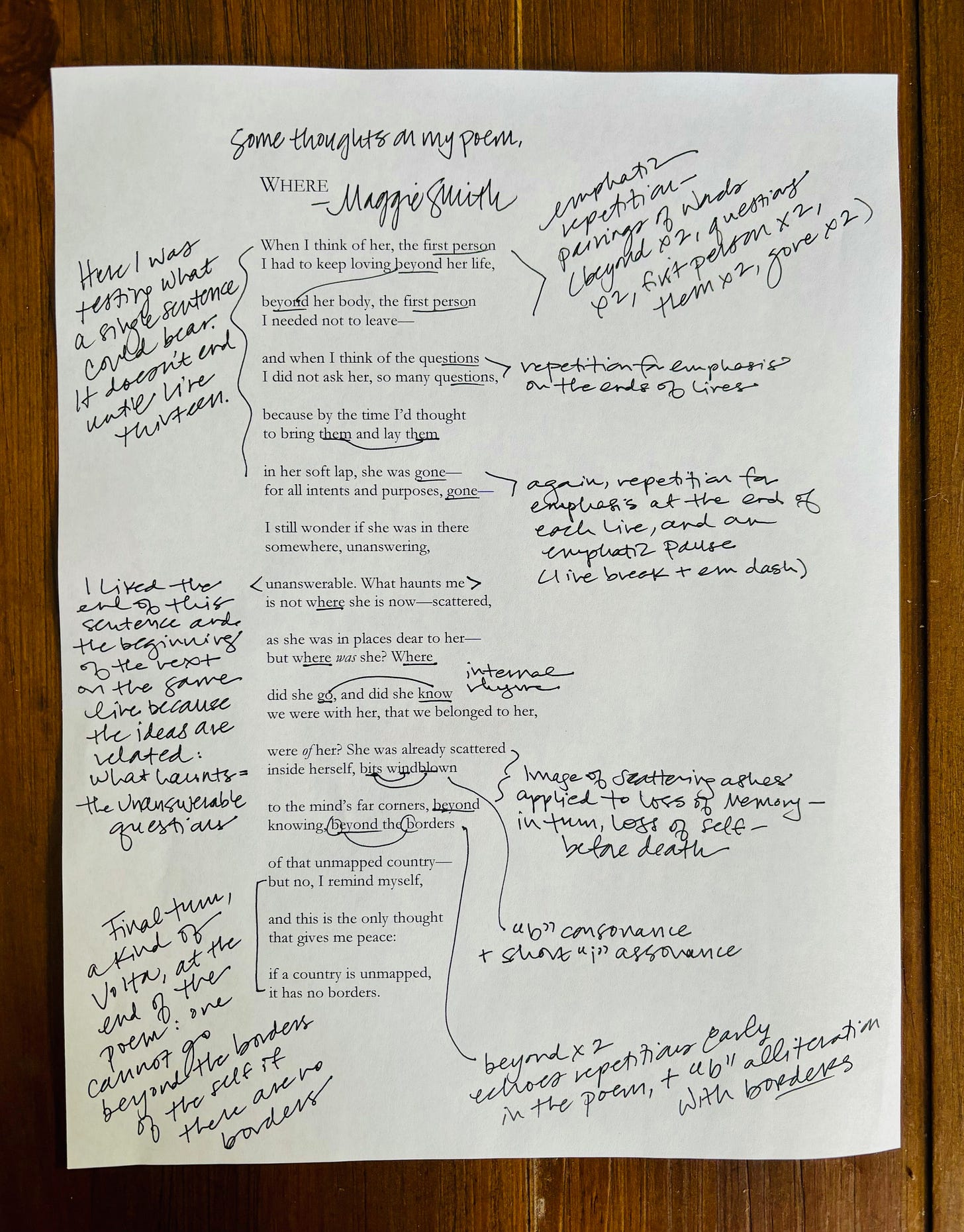Behind-the-Scenes Look: "Where"
An Annotation & Author's Note
Hi, Friend.
When I read a piece of writing, I want to know about how it was made. What was the spark? Why did the writer make those specific choices? How was the finished piece different from what they might have expected at the outset? So when I launched this newsletter, I knew that every month I’d try to answer those questions about a piece— or two, or three—of my own.
This week I’m sharing an annotation of a new poem, “Where,” which was published in American Poetry Review this year. (Thank you to editor Elizabeth Scanlon for selecting this one, along with three others.) “Where” isn’t included in a book yet, but maybe it’ll earn a spot in my next collection. We’ll see! If you look at the acknowledgments page of a poetry collection, you’re looking at a list of editors who took a chance on the poems and gave them their first homes. Thank you, Elizabeth and APR.
“Where” was inspired by my maternal grandmother, who died in October 2000 after suffering from both cancer and Alzheimer’s. The poem began with a realization that what I wonder about more than where she is now, after her death, is where was she then, at the end of her life. Watching a loved one deteriorate is heartbreaking, and witnessing my vibrant grandmother lose access to her own memories—to her own life and sense of self—rocked me to my core. It was a formative experience for me as a human being and as a writer. I don’t think it’s an accident that so much of my work is concerned with memory.
In the annotation above I’ve made notes about some of the craft decisions I made related to sound, syntax, and repetition. Some of these decisions made the initial draft possible; others came about during revision. I’ve noted some of the soundplay here: internal rhyme in go/know; short I assonance and B consonance in bits windblown; B alliteration in beyond/borders. There’s also B alliteration and short O assonance in beyond/body and long E assonance in needed/leave. Soundplay in this poem is subtle, because the music relies more on syntax and repetition.
I found myself, early on, testing the elasticity of the opening sentence. How much could it hold? How long could I extend it? The unwieldy nature of that first sentence reflects the difficulty I was having grappling with the subject matter. How best to articulate something that resists articulation? Then again, this is the work of poems, and—I think—work that poems are uniquely suited for. I think the commas create tension; those pauses that slow the reader down while at the same time building momentum because many of the sentences go on and on, and they’re loaded with repetition.
Looking closely at this poem in order to annotate it, I noticed six significant words/phrases that are repeated for emphasis: first person, beyond, questions, gone, unanswering/unanswerable (a variation), and where. Other words are repeated as well (think, them, we, her, etc.) but those first six are the ones that feel loaded with meaning. I’m reminded of a form that uses six words in a specific pattern at the ends of lines: the sestina. I know this poem was never intended to be a sestina—I didn’t draft it that way—but I can’t help but see that potential hiding inside it now.
There’s also a feature of another form in this poem—the turn in line 24, with a phrase that is often used to mark the volta in a traditional sonnet: but no. Here the speaker of the poem changes her mind and reconsiders the “argument” of the poem. Here the speaker of the poem reconsiders and reframes the loss—which is, as often is the case with Alzheimer’s and other forms of dementia, a loss within a loss, or an ongoing loss followed by a final one.
This month is National Alzheimer’s Disease Awareness Month and National Family Caregivers Month. I’m grateful for the work of the Alzheimer’s Association and the work that Maria Shriver is doing as founder of the Women’s Alzheimer’s Movement.
Take good care, all. If you’re like me, you write your way through the hard stuff, but be sure to take care of yourself in other ways, too, off the page. On that note, I’m heading out to take a walk through my neighborhood, and shuffle through the fallen leaves. Highly recommend.
Love,
Maggie




Formative . Experience . Writing our way . Notating in notes ap. The strewn leaves of flying notes wafting and grounding and composting . Seed spreader . The teacher of Patience shows up seasonally. Finally threading my music into my composition . I write how ever it comes out . I place my footprint upon my path . I sing my verse to
The flying leaves . Xo
Your explanations of your process are so amazing! thank you for sharing your thoughts about word choice and, continuing to build upon your comment a few weeks ago about seeing possibilities around poetic forms, I appreciated you pointing out sestina and volta connections. All gold! thank you, Maggie!